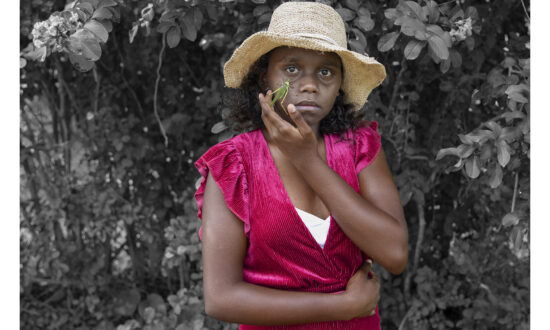The collection display Antarctica: five responses highlights a group of important new acquisitions to the Art Gallery of South Australia, including the iconic photograph A blizzard by Frank Hurley.
The photograph was among those taken by Hurley on Australia’s first expedition to Antarctica – the Australasian Antarctic Expedition (1911-14), led by Adelaide-based Douglas Mawson.
Mawson undertook his expedition during a time of intense competition between nations to map the territory, which had been declared in 1895 by the Royal Geographical Society as the last undiscovered place on Earth.
The explorer and his team endured two arduous years in Antarctica. Photography was vital to his expedition, serving both a documentary purpose and, upon his return, providing the public with images of the last great terrestrial frontier.
Mawson and Hurley travelled with the most advanced equipment, using black-and white and colour camera technology, and on their arrival constructed a darkroom at their main base. Hurley demonstrated great skill in capturing the wildlife and changing environmental conditions, and in evoking the psychological and physical pressures of the expedition.

Installation view: Antarctica: Five Responses, featuring images by Frank Hurley, AGSA, 2021. Photo: Saul Steed
No image expresses the sense of human frailty in the tremendously harsh environment better than A blizzard. The work became one of Hurley’s most iconic images from the expedition.
In A blizzard, he depicts surgeon Leslie Whetter and assistant collector John Close going out to get ice from the glacier for drinking water during a katabatic blizzard. In his book The Home of the Blizzard, Mawson described the experience of “hurricane walking” or “wind walking”, where in order to move, he and his fellow companions had to lean forward and “lie on the wind”.
Hurley’s photograph A blizzard transcends the scientific brief to “document”. Through his skilful enlarging of the negative and printing of the blue-carbon print, he created a work of great emotional power. His next major commission after Antarctica took him to the trenches of the World War I, as official war photographer for the Australian Imperial Force.
A label on the back of A blizzard indicates that Hurley exhibited it soon after his return from Antarctica at the Fine Art Society in London in 1915 as Torrent spume down the glacier hissed. The artist later re-titled the work to the more concise A blizzard.
Mawson’s admiration for the image is evident in his use of it to illustrate his book The Home of the Blizzard (1915); he also acquired the print for his own personal collection. Hurley’s photographs and film of the expedition met with great interest from audiences hungry to view a glimpse of this remote and inaccessible land.
The Art Gallery of South Australia has been able to acquire A blizzard through the generosity of the Art Gallery of South Australia Foundation Collectors Club. The remarkable work can currently be seen alongside a selection of photographs by Hurley from the expedition and an excerpt from his film The Home of the Blizzard (on loan from the National Sound and Film Archive).

Installation view: Antarctica: Five Responses, featuring Night sea by Ian North and Antarctica by Sidney Nolan, AGSA, 2021. Photo: Saul Steed
It is possible to trace Hurley’s influence on the work of later artists in the display, including the photographs of contemporary Adelaide-based artist Ian North, who travelled to Antarctica on the centenary of Mawson’s expedition. His photographic series East Antarctica 1915 draws attention to the connection between the imperial project behind the first expeditions to Antarctica and the catastrophe of World War I. The display includes a sound work, Contact and Isolation, by Philip Samartzis, whose field recordings from Antarctica in 2010 includes a recording of katabatic winds, in homage to Hurley.

Get InReview in your inbox – free each Saturday. Local arts and culture – covered.
Thanks for signing up to the InReview newsletter.
Antarctica: five responses highlights the enduring fascination artists have had with this vast continent and draws attention to the links across time between their works. The seminal place of Hurley in this legacy, and his connection to South Australian-born Douglas Mawson, makes this recent acquisition particularly interesting for Adelaide audiences.
Antarctica: Five responses is on display in Gallery 8 of the AGSA until April 26.
Maria Zagala is associate curator of Prints, Drawings & Photographs at the Art Gallery of South Australia. This article is part of InDaily’s Off the Wall series highlighting gallery treasures.

Frank Hurley, Australia, 1885 – 1962, A blizzard, from the Australasian Antarctic Expedition 1911–14, 1912, Cape Denison, blue-toned carbon print. Gift of Joan Beer, William J.S Boyle C.M, Peter and Sandra Dobson, Gwinnett Family, Roger Lang, Shane Le Plastrier, The Hon Justice Mark Livesey, David McKee AO and Pam McKee, Peter and Pamela McKee, Dick Whitington QC and Peter Wilson through the Art Gallery of South Australia Foundation Collectors Club 2019, Art Gallery of South Australia.
Support local arts journalism
Your support will help us continue the important work of InReview in publishing free professional journalism that celebrates, interrogates and amplifies arts and culture in South Australia.
Donate Here




